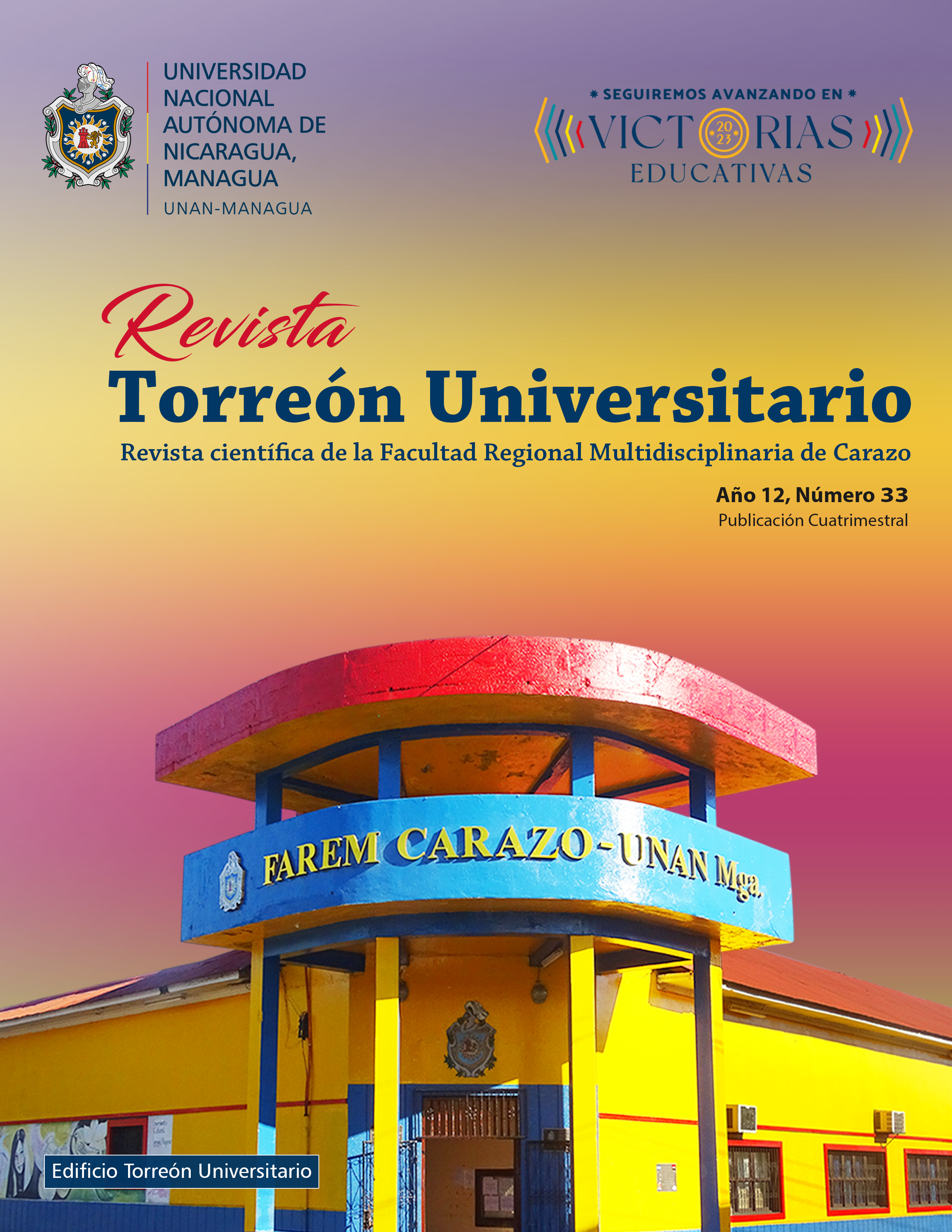Acinetobacter baumannii, multiresistant to carbapenems at the hospital level.
DOI:
https://doi.org/10.5377/rtu.v12i33.15895Keywords:
Acinetobacter baumannii, Carbapenems, genes, plasmids, Anti-infectivesAbstract
A cross-sectional descriptive study was carried out with the objective of genetically characterizing Acinetobacter baumannii, producer of carbapenemases, 16 strains resistant to carbapenems isolated from patients admitted to the German Nicaraguan public hospital were studied. The identification of the genus, species and the antimicrobial susceptibility test was carried out using the VITEK2 compact system. The synergy test was performed with ethylenediaminetetraacetic acid (10µg or 0.1 uM), from the 0.5 McFarland scale using Kirby Bauer. Genotypic characterization, multiplex PCR was performed for blaOXA23, blaOXA40, blaOXA51 and blaOXA58, also for class B genes, blaIMP, blaVIM, blaGIM, blaSIM, blaSPM and a PCR was performed for blaNDM. As a result of the study, the diversity of genes was demonstrated, 100% of the strains carried OXA51, 87.5% carried OXA40 genes, combined with OXA51, 13% presented a combination of NDM genes with OXA51, 6% of the strains presented genes VIM, GIM in combination OXA40 and OXA51, all the A. baumannii strains under study, presented multiresistance, but 100% were sensitive to colistin. It was concluded that the multiresistance in A. baumannii to carbapenems is due to blaOXA51, an intrinsic gene of this microorganism, and to the combinations of VIM, GIM, NDM and OXA40 genes, increasing the hydrolytic capacity to these antibiotics, these genes are shared by means of plasmids facilitating the vertical and horizontal transfer.
Downloads
References
(CLSI), C. a. (2020). Performance Standards for Antimicrobial Susceptibility Testing. 30 th ed. supplement M100. Wayne, PA:Clinical and Laboratory Standards Institute .
Andrés Opazo C., S. M. (2009). Bombas de expulsión multidrogas en Acinetobacter baumannii y resistencia a antimicrobianos. Rev Chil Infect 2009, 26 (6): 499-503.
Arbizù Medina, O. (2019). Carbapenemase en Pseudomonas aeruginosa en los hospitales de Managua, Nicaragua. Torreón Universitario. doi:https://doi.org/10.5377/torreon.v8i21.8851
Elena Fernández Colón;. (2009). Determinación de carbapenemasas y su relación con estructuras genéticas en aislamientos clínicos de Acinetobacter baumannii de hospitales de la ciudad de Cochabamba. BIOFARBO, 30-38. Obtenido de file:///F:/ARTICULO%20OSCAR%20FPI%20PDF%20CARBAPENEMASAS/PRIMERS%20DE%20KPC,%20ARTICULO/ALLA%20PARA%20PRIMERS/v17n1a05%20tipos%20de%20oxa%20PRIMERS%20integrones.pdf
Gonzales-Escalante1, E. (2013). METALO-β-LACTAMASAS EN AISLAMIENTOS CLÍNICOS DE Pseudomonas aeruginosa EN LIMA, PERÚ. Rev Peru Med Exp Salud Publica, 30(2):241-45.
Marcelo Pillonetto, L. A.-A. (2013). First Report of NDM-1-Producing Acinetobacter baumannii Sequence Type 25 in Brazil. Antimicrobial Agents and Chemotherapy. doi:doi:10.1128/AAC.03444-14
María José Fresnadillo-Martínez, E. G.-M.-S.-d.-E.-S.-S. (2015). Prevención de un brote de Acinetobacter baumannii en una unidad de cuidados intensivos: eficacia de diversos métodos matemáticos. Rev Esp Quimioter.
Oliver, C. J. (2010). arbapenemasas en especies del género Pseudomonas. Enferm Infecc Microbiol Clin.
P., A. D. (2005). Infecciones por Acinetobacter baumannii pan-resistente. Consideraciones epidemiológicas y de manejo antimicrobiano actualizado. Rev Chil Infect, 22 (4): 298-320.
Pasteran F., A. E. (2012). Emergence of NDM-1-producing Klebsiella pneumoniae in Guatemala. . Journal of Antimicrobial, 67:1795-1797.
Samuel Vilchez, D. R. (2009). Prevalence of diarrhoeagenicEscherichia coliin children from Leo ́n, Nicaragua. Journal of Medical Microbiology, 58,630–637. doi:10.1099/jmm.0.007369-0
Vanegas-Múnera JM, R.-V. G.-Q. (2014). Acinetobacter baumannii: importancia clínica, mecanismos de resistencia y diagnóstico. Rev CES Med, 28(2): 233-246.
Published
How to Cite
Issue
Section
License
Copyright (c) 2023 National Autonomous University of Nicaragua

This work is licensed under a Creative Commons Attribution-NonCommercial-NoDerivatives 4.0 International License.
The authors who publish in this journal agree to the following terms.
- The author or authors of the articles, essays or research grant the National Autonomous University of Nicaragua, Managua (UNAN-Managua) the editing rights (copyright) of the submitted work, therefore the University has the exclusive right to publish the article for the entire copyright period.
- These copyrights/authors authorize Torreón Universitario Magazine and the University to edit and disseminate/publish the article in said Magazine, including printed and electronic reproduction, storage, retrieval and any other type of publication, and sources of secondary information as services. of summaries and databases, they also empower it to protect the article against unauthorized use for dissemination by printed or electronic media (PDF, HTML, EPUB, XML or others).
License for use of content
The magazine uses the Creative Commons Attribution-NonCommercial-NoDerivs 4.0 International License.
Under this statement:

This journal is licensed under a Creative Commons Attribution-NonCommercial-NoDerivatives 4.0 International License. It can be copied, distributed and transmitted publicly as long as the author and source are cited (Revista Torreón Universitario), it should not be modified or used for any commercial purpose. The full license can be found at http://creativecommons.org/licenses/by-nc-nd/4.0/.



